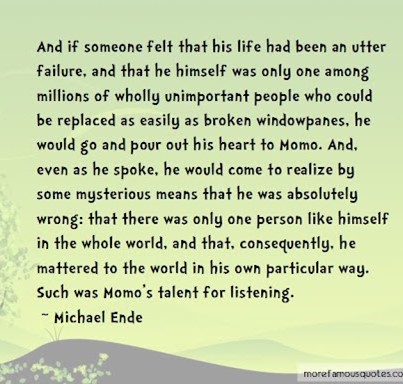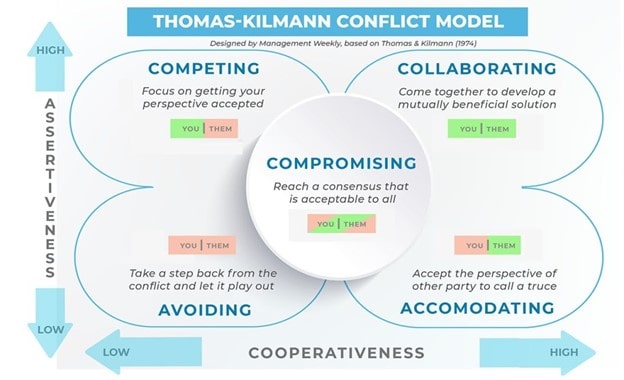I first realized I might have some minor skills in conflict resolution after college, when I discovered that many of my old suitemates stopped talking to each other if I was not there to arbitrate for them. They were different people with some very different opinions, and some of them would acknowledge later that without my “neutral” presence to alleviate those differences, they had a hard time maintaining their friendships. I put “neutral” in quotations here because I would not have considered myself neutral in any of their disagreements. In fact, conflict resolution isn’t just about resolving conflicts between other people, but resolving your own conflicts as well. What I really brought to the table was empathy, a willingness to listen, and an ability to remember the right stories at the right time.
Like many of the posts in our Transferable Skills series, this post is not meant to be a comprehensive guide to Conflict Resolution. There are countless classes and resources that can provide details and vocabulary for this skill. What this post may do is help you realize whether or not you have a natural inclination for this skill that you could strengthen. The right set of transferable skills, coupled with your technical skills, can open new career opportunities for you, if you can identify them in yourself and learn how to sell them.
Types of Conflict
Before explaining my approach to conflict resolution, it’s important to recognize that there are different types of conflict. Most people perceive any conflict as inherently bad, and in many cases it can be. If people or teams can’t see eye to eye on something and a disagreement festers, it can lead to hurt feelings, low morale, poor decision making, and stalled projects. You want to identify and address these types of harmful conflict early, because time frequently does not heal these types of wounds.
But conflict can also be good. In science, a reviewer’s critical comments on your manuscript is a form of (hopefully constructive) conflict. As you perform the experiments to address a reviewer’s concerns, you are making your hypothesis stronger. When you share data at a conference poster session, you don’t necessarily want everyone who visits your poster to agree with your conclusions. That conversation you’re having--that conflict you are resolving--will make you a better scientist. And some amount of conflict is actually critical in the business world. Companies and organizations that avoid all conflict can fall into “groupthink” and fail to evolve. Recognizing when “bad” conflict can be spun into “good” conflict is a skill in and of itself.
Conflict can also be categorized as either “personal” or “substantive”. A personality-based conflict occurs when two people cannot agree or get along with each other, regardless of the situation. If left unchecked, this type of conflict can lead to people disagreeing with each other just for the sake of disagreeing. It can be extremely toxic in a lab or work environment if left unchecked. Substantive conflict occurs when people or teams who normally get along well with each other disagree about a specific decision, direction, or goal. Resolving these types of conflicts is important for the individuals involved, and also for the labs, organizations, or businesses as a whole.
When I’m attempting to resolve a conflict, whether it’s a conflict between myself and someone else or between two other parties, the first step I always take is to identify the real source of the conflict. It can be easy to leap to the conclusion that a conflict is personal (”Person A and Person B just don’t get along”) when in fact many sources of conflict are substantive (“Person C told Person A one thing and inadvertently told Person B something else.") The majority of conflicts I address in my current role revolve around missed tasks, stalled projects, and disagreements over prioritization. The source of those conflicts can frequently be traced back to one of a few trouble spots:
- Communication (or lack thereof): Information sharing gets more challenging the bigger an organization gets, and creating new avenues of communication can create as many problems as it can solve. Many of us have heard the expression “That meeting could have been an email”, but what if that email should have been a Slack message? Or that Slack message should have actually been a meeting? Different teams frequently prefer to communicate in different ways, so the source of the conflict is not always what was communicated but how it was communicated. The next step is to come up with a viable process that will avoid such miscommunications in the future.
- Assumptions: Making incorrect assumptions can be a direct cause or consequence of lapsed communication. Making some assumptions about how something should be communicated is necessary in a large organization, because confirming that every person has read and understood every communication that gets sent out through multiple channels is not reasonable or sustainable. That said, when you know that a person or team should be involved in making a decision and you see no record of their input, it’s probably not safe to assume that they saw what they needed to see and just didn’t have anything to contribute. Also keep an eye out for the phrase “I assumed they were taking care of that”, because that can indicate confusion around...
- Ownership: Misunderstandings about who is responsible for what tasks or projects is a common source of conflict. For instance, at Addgene, there are two teams whose primary role is customer support, but there are eight other teams who still retain a customer support element amongst their other responsibilities. Knowing which aspects of customer support each team “owns” is critical for day-to-day operations and keeping our customers happy, but inevitably there will be gray areas that either a) overlap with multiple teams or b) fall into a gap between teams that nobody is really owning. Conflict in this latter scenario usually manifests as the assumption “I thought that was X’s job”. It’s certainly resolvable, but will likely require a manager to explicitly assign the responsibility in question to a specific person or team.
What Makes You a Good Conflict Resolver?
The first and foremost sub-skill to have here is pretty intuitive: You need to be willing to face conflict head-on. That doesn’t mean you have to like conflict. Very few people do, and it’s best to be wary of anyone who is actually looking for a fight. But you also can’t be the type of person who avoids conflict at all costs or actively runs away from it. That can mean a willingness to make yourself temporarily uncomfortable for the sake of a common good. If you can get past that hurdle, there are a few more tools that can come in handy:
- Empathy: If you often find yourself in confrontational situations with others because you simply cannot see things from their point of view and can’t understand why they’re upset, conflict resolution is likely not one of your strengths. Empathizing with people, especially people with whom you strongly disagree, is a critical component of conflict resolution. Having empathy does not mean you like everyone you meet. Most people can’t maintain that level of positivity past the age of five. But it does mean that even if you find someone annoying or disagreeable, you recognize their feelings as valid.
- Listening: In one of my favorite books, Michael Ende’s Momo, the title character endears herself to the nearby village (and to the reader) by simply listening. Chances are, you know someone like this, even if you’re not one of these people yourself.

Fig 1: Quote from Michael Ende, courtesy of morefamousquotes.com
A good listener absorbs and remembers and makes the teller feel heard. I am not always a stupendous listener, but I aspire to be. If you don’t at least aspire to be a good listener and consciously practice it, you will not be great at resolving conflicts. - Institutional Knowledge: Of the tools I’m mentioning here, this may be the most controversial, so I would like to qualify it. If you are attempting to resolve conflicts within a given organization, it can help tremendously to have as much context as possible. When I am trying to resolve a conflict between two different teams at work, I don’t just rely on what I know about those particular teams at that given time. I think about how previous iterations of those teams resolved similar issues in the past, or how completely different teams are tackling comparable conflicts. Is this level of domain knowledge absolutely necessary for conflict resolution? Definitely not. But it can help, and if and when you find yourself transferring this skill to another job, it will be important to retain the stories and examples that have guided your resolution processes in the past.
Types of Resolution
There are of course many other types of conflict resolution. In compromise, you are trying to come to a consensus that all conflicted parties will accept. If you are able to broker a compromise well, you can help everyone walk away from a conflict happy, feeling they each got enough of what they wanted. However, a poorly brokered compromise could leave everyone feeling vaguely unsatisfied. In arbitration, there is more of a winner and loser–one party will be considered in the right, and one in the wrong. If you arbitrate, one party might get exactly what they want, but that means the other party will feel punished or invalidated. Both compromise and arbitration might remedy short-term substantive conflicts, but they could also aggravate long-term personal conflicts.
Transitioning a conflict into a collaboration may not be the easiest resolution to accomplish, but there is a potential for long-term gains when you can do it. If Party X proposes solution A, and Party Y proposes solution B, with proper guidance X and Y might be able to work together to create solution C. And if a conflict resolver does their job well, not only will solution C be better than either A or B, but the two parties will have learned that by working together, they can create unique solutions that benefit themselves and their organization. Resolving conflicts is great, but avoiding unnecessary future conflicts while giving people the tools to resolve necessary ones on their own is even better.
The Thomas Kilmann Conflict Model describes 5 basic approaches to conflict resolution based on various levels of assertiveness and cooperation: avoiding, competing, accommodating, collaborating, and compromising. Though there may be a time and place for avoiding, competing, or accommodating, if you find yourself gravitating most frequently towards these approaches, you may need to put more conscious effort into your conflict management skills. It’s also completely OK to recognize that conflict resolution may never be a strength for you. But if you are a problem solver, and you think of conflicts as problems you are willing and able to solve, don’t take that skill for granted. When you go on interviews or are looking for a promotion, have some solid examples of times when you have used your empathy, listening skills, and institutional knowledge to resolve conflicts. Conflict in the workplace is inevitable, but having who can help resolve these conflicts is not inevitable. When you know you are bringing this asset to your job, you can become a valuable asset yourself.

|
| Fig 2: A diagram of the Thomas-Kilmann Conflict Model, courtesy of https://managementweekly.org/thomas-kilmann-conflict-resolution-model/ |
References and Resources
References
Thomas-Kilmann Conflict Model, Management Weekly, https://managementweekly.org/thomas-kilmann-conflict-resolution-model/, accessed Jan. 3, 2022.
Additional Resources on the Addgene blog
Management for Scientists
Transferable Skills Guide: Leadership
Transferable Skills Guide: Teamwork






Leave a Comment